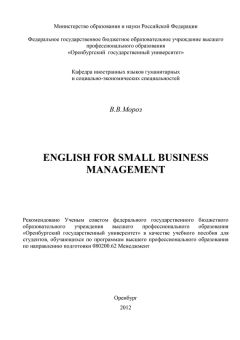Текст книги "English for Small Business Management"

Автор книги: Виктория Мороз
Жанр: Малый бизнес, Бизнес-Книги
сообщить о неприемлемом содержимом
Текущая страница: 1 (всего у книги 7 страниц) [доступный отрывок для чтения: 2 страниц]
В. В. Мороз
English for Small Business Management
Introduction
Данное учебное пособие предназначено для обучения студентов направления подготовки 080200.62 Менеджмент чтению специальной литературы как самостоятельно, так и в аудитории.
Цель данного учебного пособия – изучить ключевые темы в области управления предприятий, расширить как терминологический словарный запас, так и общеупотребительной лексики, развить умения извлекать необходимую информацию, анализировать и систематизировать ее.
Учебное пособие включает в себя пять разделов, состоящих из специальных текстов, упражнений на освоение и закрепление лексики, грамматических упражнений, глоссария, а также проектных заданий и заданий практической направленности.
В каждом разделе предлагаются специализированные тексты, предназначенные как для самостоятельной, так и для аудиторной работы с использованием технологии развития критического мышления, что позволяет сформировать у студентов навыки работы с текстом, в группе и самостоятельно, не только при изучении иностранного языка, но и других дисциплин.
Тексты в разделах сопровождаются упражнениями на развитие навыков работы со словарем, расширение словарного состава как общеупотребительной, так и профессиональной лексики. Каждый раздел завершается упражнениями практической направленности для закрепления пройденного материала.
1 Unit 1. Family Business Opportunities
1.1 Class work. The family business: a unique institution
1.1.1 Exercise 1. Draw a family tree arranging the following words in a proper order
Son, daughter, mother, father, sister, brother, grandparents, nephew, niece, cousin, aunt, uncle, wife, husband, spouse.
1.1.2 Exercise 2. Before you read, make a chart and put down everything you know about family business
1.1.3 Exercise 3. Divide the class into groups of four to read texts A, B, C, and D. Then share the information read with the group mates
1.1.3.1 Text A. What Is a Family Business?
Vocabulary Notes:
entrepreneurship – предпринимательство;
to strive for – прилагать усилия, стараться, стремиться;
to pursue – заниматься ч. – л., иметь профессию;
to distinguish – отличать, выделять, служить отличительным признаком;
to keep the books – вести бухгалтерские книги;
to some extent – в некоторой степени.
One of the routes to entrepreneurship is that of entering a family business. Many sons and daughters of business owners have the option of joining the firm founded by their parents or grandparents. Family leaders may, in fact, strive for continuation of a family business over several generations, thereby creating opportunities for children or other relatives to pursue entrepreneurship in that business. Young family members must then decide, often during their college years, whether to prepare for a career in the family business. This decision should be based on an understanding of the dynamics of such a business. A number of features distinguish the family firm from other types of small businesses. Its decision making, for example, involves a mixture of family and business values.
Family business – a company in which family members are directly involved in the ownership and/or functioning

A family business is characterized by ownership or other involvement by two or more members of the same family in its life and functioning. The nature and extent of that involvement varies. In some firms, family members may work full-time or part-time. In a small restaurant, for example, one spouse may serve as host and manager, the other may keep the books, and the children may work in the kitchen or as servers.
Most family businesses are small. However, family considerations may continue to be important even when such businesses become large corporations. Companies such as WalMart Stores, Levi Strauss and Company, Ford Motor Company, and Marriott Corporation are still recognized, to some extent, as family businesses.

1.1.3.2 Text B. Family and Business Overlap
Vocabulary Notes:
to overlap – частично совпадать, перекрывать;
to nurture – выращивать, воспитывать, обучать;
in the short run – в ближайшем будущем, в ближайшее время;
tension – напряжение, напряженное состояние;
consistent – последовательный, стойкий;
to be concerned with – иметь отношение, касаться.
Any family business is composed of both a family and a business. Although these are separate institutions – each with its own members, goals, and values – they overlap in the family firm.
Families and businesses exist for fundamentally different reasons. The family's primary function relates to the care and nurture of family members, while the business is concerned with the production or distribution of goods and/or services. The family's goals are the fullest possible development of each member, regardless of limitations in ability, and the provision of equal opportunities and rewards for each member. The business's goals are profitability and survival. These goals may be either in harmony or in conflict, but it is obvious that they are not identical. In the short run, what's best for the family may or may not be what's best for the business.
In many cases, one decision may serve both sets of overlapping interests. However, the differing interests can also create tension and sometimes lead to conflict. Relationships among family members in a business are more sensitive than they are among unrelated employees. For example, a manager may become angry at an employee who consistently arrives late, but disciplining the employee is much more problematic if he or she is also a family member.
1.1.3.3 Text C. Decisions Affecting Both Business and Family
Vocabulary Notes:
concern – забота, дело, интерес;
to impact – ударять(ся), сталкиваться;
to opt – выбирать;
to complicate – усложнять;
to survive – выживать;
unduly – неправильно, чрезмерно.

The overlap of family concerns and business interests in the family firm complicates the management process. Many decisions impact both business and family. Consider, for example, a performance review session between a parent-boss and a child-subordinate. Even with non-family employees, performance reviews can be potential minefields. The existence of a family relationship adds emotional overtones that vastly complicate the review process.
Which comes first, the family or the business? In theory, at least, most people opt for the family. Few business owners would knowingly allow the business to destroy their family. In practice, however, the resolution of such tensions becomes difficult. For example, a parent, motivated by a sense of family responsibility, may become so absorbed in the business that he or she spends insufficient time with the children.
If the business is to survive, its interests cannot be unduly compromised to satisfy family wishes. To grow, family firms must recognize the need for professional management and the fact that family concerns must sometimes be secondary.
The health and survival of a family business require a proper balancing of business and family interests. Otherwise, results will be unsatisfactory to both.
1.1.3.4 Text D. Advantages of Family Involvement in the Business
Vocabulary Notes:
to derive – получать, извлекать;
through thick and thin – несмотря ни на какие препятствия, трудности;
commitment – обязательство;
reluctant – делающий ч. – л. с неохотой;
to hinge on – зависеть от;
to be at stake – быть поставленным на карту, находиться под угрозой.
Problems associated with family businesses can easily blind young people to the advantages that can be derived from participation of family members in the business. The many positive values associated with family involvement should be recognized and used in the family firm. A primary benefit comes from the strength of family relationships. Members of the family are drawn to the business because of family ties, and they tend to stick with the business through thick and thin. A downturn in business fortunes might cause non-family managers to seek greener pastures elsewhere. A son or daughter, however, is reluctant to leave. The family name, the family welfare, and, possibly, the family fortune are at stake. In addition, a person's reputation as a family member may hinge on whether he or she can continue the business that Mom or Grandfather built.
Family members may also sacrifice income to keep a business going. Rather than draw large salaries or high dividends, they permit such resources to remain in the business for current needs. Many families have gone without a new car or new furniture long enough to let the new business get started or to get through a period of financial stress.
Some family businesses use the family theme in advertising to distinguish themselves from their competitors. Such advertising campaigns attempt to convey the fact that family-owned firms have a strong commitment to the business, high ethical standards, and a personal commitment to serving their customers and the local community.

1.2 Class Work. The culture of a family business
1.2.1 Exercise 1. Look through the text and prove the following statements
1 The way the firm is doing business and its priorities is called organizational culture.
2 In a family business the values of a founder can become the values of both his family and business.
3 A number of cultural patterns can be applied in some aspects of family firms.
Vocabulary Notes:
priority – приоритет, порядок срочности, очередности;
particular – индивидуальный, частный, отдельный, особый;
to pick up – подхватить, научиться;
distinctive – отличительный, характерный;
competitive advantage – конкурентное преимущество;
to cater (to, for) – потворствовать, угождать;
to discern – различать, распознавать, отличать, проводить различие;
to appreciate – высоко ценить, оценивать по достоинству;
commitment – обязательство;
legacy – наследство, наследие;
facet – аспект, грань.
Family firms, like other business organizations, develop certain ways of doing things and certain priorities that are unique to each particular firm. These special patterns of behaviors and beliefs are often described as organizational culture. As new employees and family members enter the business, they tend to pick up these special viewpoints and ways of operating.
Organizational culture – patterns of behaviors and beliefs that characterize a particular firm
The Founder's Imprint on the Culture
The distinctive values that motivate and guide an entrepreneur in the founding of a firm may help to create a competitive advantage for the new firm. For example, the founder may cater to customer needs in a special way and make customer service a guiding principle for the firm. The new firm may go far beyond normal industry practices in making sure customers are satisfied, even if it means working overtime or making a delivery on Saturday. Those who work in the business quickly learn that customers must always be handled with very special care.
In a family business, the founder's core values may become part of both the business culture and the family code – "the things we believe as a family." John Robben, the second-generation CEO of RobToy, Inc., describes the legacy of his father, who founded the firm:
But he left us much more than his confidence, and his willingness to take a chance. My father never lied; nor did he ever cheat anyone or take a dollar he didn’t honestly earn. He passed these values on, first to me and then, through me, to his grandchildren. It's funny how that worked. He never talked about these things, he just did them.
The last sentence above tells us something about the way cultural values are transmitted. Family members and others in the firm learn what's important and absorb the traditions of the firm simply by functioning as part of the organization.
Cultural Patterns in the Firm
The culture of a particular firm includes numerous distinctive beliefs and behaviors. By examining those beliefs and behaviors closely, we can discern various cultural patterns that help us understand the way in which the firm functions.
W. Gibb Dyer, Jr., a professor at Brigham Young University, has identified a set of cultural patterns that apply to three facets of family firms: the actual business, the family, and the governance (board of directors) of the business.
An example of a business pattern is a firm's system of beliefs and behaviors concerning the importance of quality. Members of an organization tend to adopt a common viewpoint concerning the extent to which effort, or even sacrifice, should be devoted to product and service quality. When leaders of a firm consistently demonstrate a commitment to quality, they encourage others to appreciate the same values. By decisions and practices that place a high priority on quality, therefore, leaders in a family business can build a business pattern that exhibits a strong commitment to producing high-quality goods and services.
1.3 Home Assignment. Family roles and relationships
1.3.1 Exercise 1. Read the text at home making notes the following way: in the left-side column put down the main statements, definitions or terms, in the right-side column your comments, thoughts, etc.
Vocabulary Notes:
simultaneous – одновременный;
to exert – напрягать (силы), оказывать влияние;
diligence – прилежание, усердие старание;
to counsel – давать совет, рекомендовать;
to perplex – ставить в тупик, запутывать, усложнять;
integral – неотъемлемый, существенный, целый;
to eclipse – затмевать, заслонять;
to dissipate – расточать, растрачивать (время, силы);
zest – интерес, энергия, живость;
strain – напряжение;
collaboration – сотрудничество, совместная работа;
to groom for – готовить к определенной деятельности, карьере;
aptitude – склонность, пригодность, способности;
bent – склонность, наклонность;
aspiration – стремление, сильное желание (достичь ч. –л.)
mould (AmE mold) – форма, лекало, шаблон; характер;
self-esteem – чувство собственного достоинства, самоуважение;
on one’s own – самостоятельно, по собственной инициативе.
Mom or Dad, the Founder
A common figure in family businesses is the man or woman who founded the firm and plans to pass it on to a son or a daughter. In most cases, the business and the family grow simultaneously. Some founders achieve a delicate balance between their business and family responsibilities. Others must exert great diligence to squeeze out time for weekends and vacations with the children.
Entrepreneurs who have children typically think in terms of passing the business on to the next generation. Parental concerns involved in this process include the following:
– Does my son or daughter possess the temperament and ability necessary for business leadership?
– How can I, the founder, motivate my son or daughter to take an interest in the business?
– What type of education and experience will be most helpful in preparing my son or daughter for leadership?
– What timetable should I follow in employing and promoting my son or daughter?
– How can I avoid favoritism in managing and developing my son or daughter?
– How can I prevent the business relationship from damaging or destroying the parent-child relationship?
Of all the relationships in a family business, the parent-child relationship has been the most troublesome. The problem has been recognized informally for generations. In more recent years, counseling has developed, seminars have been created, and books have been written about such relationships. In spite of this extensive attention, however, the parentchild relationship continues to perplex numerous families involved in family businesses.
Couples in Business

Some family businesses are owned and managed by husband-wife teams. Their roles may vary depending on their backgrounds and expertise. In some cases, the husband serves as general manager and the wife runs the office. In other cases, the wife functions as operations manager and the husband keeps the books. Whatever the arrangement, both parties are an integral part of the business.
A potential advantage of the husband-wife team is the opportunity it affords a couple to share more of their lives. For some couples, however, the potential benefits become eclipsed by problems related to the business. Differences of opinion about business matters may carry over into family life. And the energies of both parties may be so dissipated by their work in a struggling company that little zest remains for a strong family life.
Adele Bihn and Murray P. Heinrich of San Jose, California have experienced both the joys and strains of working together as business partners. After 12 years of marriage and collaboration in their business, Data Marketing, Inc., they are described as "still blissfully happy." Adele, mother of their four children, owns 50 percent of the company and serves as president. Murray owns the other 50 percent and heads up product research. To maintain their happiness, they must deal with strains imposed by the business. They have worked together to resolve these pressures by using a variety of methods, including semiannual visits with a marriage counselor, annual away-fromwork business strategy sessions, Saturday morning breakfast dates without the children, and annual separate vacations. Their experience shows that entrepreneurial couples can maintain good marriages, but it also shows that such couples must devote special effort to both business and family concerns.
Sons and Daughters
Should sons and daughters be groomed for the family business, or should they pursue careers of their own choosing? In the entrepreneurial family, a natural tendency is to think in terms of a family business career and to push a child, either openly or subtly, in that direction. Little thought, indeed, may be given to the basic issues involved, which include the child's talent, aptitude, and temperament. The child may be a chip off the old block but may also be an individual with different bents and aspirations. He or she may prefer music or medicine to the world of business and may fit the business mold very poorly. It is also possible that the abilities of the son or daughter may simply be insufficient for a leadership role. (Of course, a child's talents may be underestimated by parents simply because there has been little opportunity for development.)
Another issue is personal freedom. We live in a society that values the right of the individual to choose his or her own career and way of life. If this value is embraced by a son or daughter, that child must be granted the freedom to select a career of his or her own choosing.
A son or daughter may feel a need to go outside the family business, for a time at least, to prove that "I can make it on my own." To build self-esteem, he or she may wish to operate independently of the family. Entering the family business immediately after graduation may seem stifling – "continuing to feel like a little kid with Dad telling me what to do."
If the family business is profitable, it does provide opportunities. A son or daughter may be well advised to give serious consideration to accepting such a challenge. If the business relationship is to be satisfactory, however, family pressure must be minimized. Both parties must recognize the choice as a business decision as well as a family decision – and as a decision that may conceivably be reversed.

1.3.2 Exercise 2. Translate the following text in written form
Special features of family firm management.
The complexity of relationships in family firms creates a demand for enlightened management. To a considerable extent, this just means good professional management. However, certain special techniques are useful in dealing effectively with the complications inherent in the family firm.
The Need for Good Management
Good management is necessary for the success of any business, and the family firm is no exception. Significant deviations for family reasons from what we might call good management practices, therefore, only serve to weaken the firm. Such a course of action runs counter to the interests of both the firm and the family. For the benefit of both, we suggest three management concepts that are particularly relevant to the family firm:
1 A family firm must be able to rely on the competence of its professional and managerial personnel. It cannot afford to accept and support family members who are incompetent or who lack the potential for development.
2 Favoritism in personnel decisions must be avoided. If possible, the evaluation of family members should involve the judgment of non-family members – those in supervisory positions, outside members of the board of directors, or managers of other companies in which family members have worked.
3 Plans for succession, steps in professional development, and intentions regarding changes in ownership should be developed and discussed openly. Founders who recognize the need for managing the process of succession can work out plans carefully rather than drift toward it haphazardly. Lack of knowledge regarding the plans and intentions of key participants creates uncertainty and possible suspicion. The planning process can begin as the founder or the presiding family member shares his or her dream for the firm and family participation in it.
The family firm is a business – a competitive business. The observance of these and other fundamental precepts of management will help the business thrive and permit the family to function as a family. Disregard of such considerations will pose a threat to the business and impose strains on family relationships.
1.3.3 Exercise 3. Read the text and render the main idea of it
Vocabulary notes:
consideration – рассмотрение, обсуждение, внимание, соображение;
inside track – выгодное положение, преимущество;
advancement – успех, прогресс, продвижение;
frustration – расстройство (планов), крушение (надежд), разочарование;
to negotiate – вести переговоры, договариваться;
to buy out – выкупать;
to aspire – стремиться;
feud – длительная вражда, междоусобица;
to perceive – воспринимать, понимать, осознавать, постигать, ощущать;
hazard – риск, опасность;
to plague – досаждать, надоедать, беспокоить.
Nonfamily Employees in a Family Firm
Even those employees who are not family members are affected by family considerations. In some cases, their opportunities for promotion are lessened by the presence of family members who seem to have the inside track. What parent is going to promote an outsider over a competent daughter or son who is being groomed for future leadership? The potential for advancement of non family members, therefore, may be limited, and they may experience a sense of unfairness and frustration.
One young business executive, for example, worked for a family business that operated a chain of restaurants. When hired, he had negotiated a contract that gave him a specified percentage of the business based on performance. Under this arrangement, he was doing extremely well financially – that is, until the owner called on him to say, "I am here to buy you out." When the young man asked why, the owner replied, "Son, you are doing too well, and your last name is not the same as mine!"
The extent of limitations on non-family employees will depend on the number of family members active in the business and the number of managerial or professional positions in the business to which non-family employees might aspire. It will also depend on the extent to which the owner demands competence in management and maintains an atmosphere of fairness in supervision. To avoid future problems, the owner should make clear, when hiring nonfamily employees, the extent of opportunities available and identify the positions, if any, that are reserved for family members.
Those outside the family may also be caught in the crossfire between family members who are competing with each other. Family feuds make it difficult for outsiders to maintain strict neutrality. If a non-family employee is perceived as siding with one of those involved in the feud, he or she will lose the support of other family members. Hard-working employees often feel that they deserve hazard pay for working in a firm plagued by an unusual amount of family conflict.
1.4 Homereading. Transfer of Ownership
1.4.1 Exercise 1. Remember the following terms:
succession – наследование, правопреемство;
inheritance – наследование, наследство;
estate – имущество, состояние;
share – доля, часть, пай; брит. акция;
holdings – вклады;
to bequeath – завещать имущество;
tax – налог;
warehouse – склад, хранилище, оптовый магазин;
distributor – агент по продаже, оптовый торговец;
assets – активы, средства, капитал, фонды, имущество;
business property – собственность фирмы;
monetary values – денежные ценности.

A final and often complex step in the succession process in the family firm is the transfer of ownership. Questions of inheritance affect not only the leadership successor but also other family members having no involvement in the business. In distributing their estate, parents-owners typically wish to treat all their children fairly, both those involved in the business and those on the outside.
One of the most difficult decisions is determining the future ownership of the business. If there are several children, for example, should they all receive equal shares? On the surface, this seems to be the fairest approach. However, such an arrangement may play havoc with the future functioning of the business. Suppose that each of five children receives a 20 percent ownership share even though only one of them is active in the business. The child active in the business – the leadership successor – becomes a minority stockholder completely at the mercy of relatives on the outside.
Ideally, the founder has been able to arrange his or her personal holdings to create wealth outside the business as well as within it. In this way, he or she may bequeath comparable shares to all heirs while allowing business control to remain with the child or children active in the business.
Tax considerations are relevant, of course, and they tend to favor gradual transfer of ownership to all heirs. As noted above, however, transfer of equal ownership shares to all heirs may be inconsistent with future efficient operation of the business. Tax laws should not be allowed to blind one to possible adverse effects on management.
One creative ownership transfer plan was worked out by a warehouse distributor in the tire industry. The distributor's son and probable successor was active in the business. The distributor's daughter was married to a college professor at a small southern university. Believing the business to be their most valuable asset, the owner and his wife were concerned that both the daughter and the son receive a fair share. Initially, the parents decided to give the business real estate to their daughter and the business itself to their son, who would then pay rent to his sister. After discussing the matter with both children, however, they developed a better plan whereby both the business property and the business would go to the son.
The daughter would receive all nonbusiness assets plus an instrument of debt from her brother, intended to balance the monetary values. This plan was not only fair but also workable in terms of the operation and management of the firm.
Planning and discussing the transfer of ownership is not easy, but such action is recommended. Over a period of time, the owner must reflect seriously on family talents and interests as they relate to the future of the firm. The plan for transfer of ownership can then be firmed up and modified as necessary when it is discussed with the children or other potential heirs.
1.4.2 Exercise 2. Remember the following phraseological units

1.4.3 Exercise 3. Arrange the following words into 2 columns: synonyms and antonyms
Intensive, full-time, secondary, day-time, include, primary, evening, exclude, part-time, extensive
1.4.4 Exercise 4. Complete the following chart:

1.4.5 Exercise 5. Remember the difference in the meaning of the following words:

1.4.6 Exercise 6. Remember the following terms:
Distribution, production, profitability, customer, delivery, income, benefit, salary, dividend, consumer, subordinate, employee.
1.4.7 Exercise 7. Add prefixes in-, un-, mis-, il-, ir-, dis– to the following words
Sufficient, possible, responsible, satisfactory, advantage, formally, dependent, certainty, competent, consistent.
1.4.8 Exercise 8. Remember the difference in the meaning

1.4.9 Exercise 9.
Complete each sentence with a passive verb. You may need a negative form.
1. Somebody damaged the goods in transit. The goods __________ in transit.
2. Thousands of people see this advert every day. This advert ___________ by thousands of people every day.
3. They will not finish the project by the end of the month. The project __________ by the end of the month.
4. They have closed fifty retail outlets over the last year. Fifty retail outlets ___________ over the last year.
5. We are reviewing all of our IT systems. All of our IT systems ____________.
6. We cannot ship your order until we receive payment. Your order __________ until we receive payment.
1.4.10 Exercise 10.
Open the brackets, use the verbs in the Passive. Pay attention to the time.
1. I don’t think your proposal (to accept) at the next meeting.
2. The company (to found) by the father of the present chairman in 1950.
3. All our machines (to service) by highly trained technicians.
4. The machine isn’t working again! It (to repair) yesterday by the technician.
5. Last year the conference (to open) by someone from London Business School.
6. I (to show) round the factory by someone, and then I’ll meet the sales team.
1.4.11 Exercise 11.
Rewrite the sentences using the passive where possible. You may need a negative form.
1. Our R&D department has discovered a promising drug.
2. The inflation rate went down by 0.5 % last month.
3. One of our best young designers created this line.
4. I’m sorry, we can’t do that.
Правообладателям!
Данное произведение размещено по согласованию с ООО "ЛитРес" (20% исходного текста). Если размещение книги нарушает чьи-либо права, то сообщите об этом.Читателям!
Оплатили, но не знаете что делать дальше?








































